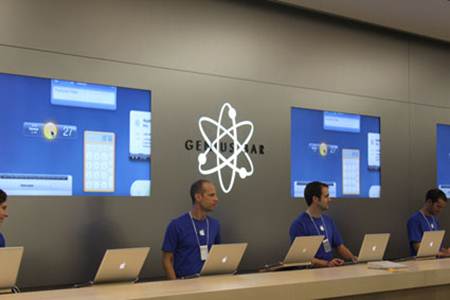Because of the onslaught of appointments –
four an hour per Genius – the bar runs on a tight schedule, micromanaged to the
minute by Apple’s software. Apple recommends that you check in for your Genius
Bar appointment at least 10 to 15 minutes in advance.

Apple
recommends that you check in for your Genius Bar appointment at least 10 to 15
minutes in advance
It’s best to do what Apple says. If you
aren’t checked in within five minutes of your designated time, the computer
sends a warning to the Genius assigned to your case; if you’re late, the
computer cancels the appointment.
You can check in by speaking to any
Specialist on the floor or by using the Apple Store app. The app is really the
best way – it sends you a banner alert when the Genius on deck is ready, so you
can browse through the store without missing your appointment.
The appointment.
Genius Bar appointments last 15 to 20
minutes per customer; often Geniuses are working with several customers at once.
Rest assured that they aren’t ignoring you or trivializing your case. Think of
the Genius Bar as something like a trauma ward – employees want to help as many
people as possible, so they have to dart from customer to customer. Most
problems can be resolved during the initial appointment; if it’s parts-related
and the store has the part in stock, all but the most difficult repairs can be
executed within an hour while you wait. (The trickiest repairs usually take no
longer than a day, though a part can take up to a week to arrive, depending on
what it is.)
The bottom line is that Apple Stores offer
a wide array of services, but the best way to get the most from them is to play
by the Apple Store rules. Do that and you’re likely to walk away a happy customer.
Hard drive failures are inevitable. Hard
drives have spinning platters and fast-moving arms. Like all things with small
moving parts, they are very fragile, almost designed to fail. As you can
imagine, Geniuses have to give people bad news about their drives all the time.
Her name was Susan. She was a middle-aged
woman, who had a 15in PowerBook with a hard drive that sounded like a tin full
of rocks going through a clothes dryer.
Even though I could guess the problem as
soon as I heard the grinding noise, I went through the motions of
troubleshooting it. I booted her PowerBook from an external drive, opened Disk
Utility and … nothing. The drive wouldn’t repair and when I attempted to mount
it, the machine locked up. As I began to break the news to her, she started to
cry and before long she was sobbing. A few tears weren’t unusual at the Bar,
but this was different. I could tell she’d lost more than just an essay or some
work project.

She
had all the photos of her small children on the hard drive
After she calmed down, Susan explained that
her children had been killed in a car accident a few years prior. She had all
the photos of her small children on the hard drive. Pictures from her
pregnancies were gone. Photos of birthday parties and opening presents on
Christmas were gone. Watching her cry, I realized that she was reliving the
pain of losing her children.
Like most Mac users at that time, she had
no backup of her files. Even before the days of Time Machine, as a Genius, the
natural tendency was to have a ‘tough luck’ world view when it came to data
loss. It was easy to look at customers who lost data and not feel any pity,
figuring that they had got themselves into that position by not having a backup
of their data.
I operated with that mindset a lot of the
time. I think it’s fair to say most Geniuses do. Obviously, in a case like
Susan’s, none of that applied. To feel anything but pity and sadness would have
been plain wrong. This woman had already been through so much and it seemed
cruel of the universe to have added this, too.
Susan’s appointment was a prime example of
just how emotional being a Mac Genius could be at times. On one hand, I knew
that she should’ve backed up the pictures if they were the only copies she had,
but on the other, I wanted Apple to cover the cost of the repair and data
recovery, just to make her life a little easier. Really, I just wanted to let
this woman cry on my shoulder.
Sadly, at that point, my hands were tied.
When a hard drive is in such bad shape, the only hope for retrieving the data
is to send the drive to a hardware data recovery company. The process has a
mixed rate of success and is very expensive, but it was Susan’s only hope. She
didn’t even blink when I told her how much it was going to cost her.
Against all odds, Susan’s story ended well.
The company was able to recover her photos and she came back six weeks later
for us to help her set up a backup solution for the future.
She was incredibly lucky that her data was
recoverable, but I knew it was wrong to frame things in that light. Instead, I
celebrated with her at her follow-up appointment. I was genuinely happy that
she had the photos of her children back. We were able to connect on a personal
level, despite the fact that the Genius Bar was, ultimately, a business. Her
story could’ve been much worse – I’m just thankful it wasn’t.